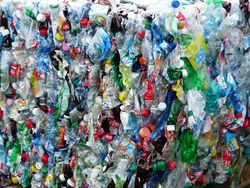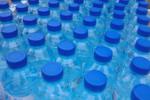Plastic
Plastic is a synthetic material made from a wide range of organic polymers such as polyethylene, PVC, nylon, etc., that can be molded into shape while soft and then set into a rigid or slightly elastic form. It is one of the most versatile yet strong materials we know of today. It is used to make almost any type of food container, helmets, bottles,to even medical equipment. But the draw back is that the synthetic material also has harmful imprints on the environment and on human health. Since its mass production in the 1940's, plastic has been admired for its sets of unique qualities. Without plastics we might not be where we are today in scientific community. Without it everything would be made of mostly organic material which would degrade and be destroyed easily. The origins of the plastics we know today started off very slowly, but picked up and now there is an estimated 300 million pounds of it produced each year. Even though plastics are a inorganic substance they are derived from organic substances. Plastics are made from oil, a carbon-rich raw material, and they are large carbon-containing compounds. Common substances used to make plastic are cellulose, coal, natural gas, salt and, of course, crude oil.
History
The first man made plastic was made by Alexander Parkes who demonstrated it publicly in the 1862 Great International Exhibition in London. He called the material he created Parkensine. It was an organic material derived from cellulose. It was significant because once it was heated it could be easily molded, and when cooled it could hold its shape rigidly and was very tough. In 1868 John Wesley Hyatt invented a cellulloid that was intended to be used as a substitute for the expensive ivory in billiard balls. He first tried using collodion, an organic substance, after spilling a bottle of it and discovering that it dried into a hard plastic like substance. It was similar to what he was looking for but, it wasn't strong enough to be used as a billiard ball. That's when he added camphor, a derivative of the laurel tree. It could then be molded with heat and pressure into a much stronger material. Celluloid later became famous as the first flexible photographic film used for still photography and motion pictures. He had created celluloid in a strip for film. By 1900, it was in very high demand for making movies and using film. After cellulose nitrate, formaldehyde was the next big thing in the advancement of plastic. In 1897, attempts to manufacture white chalkboards led to casein plastics. In 1899 Arthur Smith received British Patent 16,275, for "phenol-formaldehyde resins for use as an ebonite substitute in electrical insulation". Which was the first patent for the processing of formaldehyde resin. In 1907, Leo Hendrik Baekeland improved phenol-formaldehyde reactions and called it Bakelit. It became the first synthetic resin to be sold commercially.[1]
How it's made
Even though plastics are an inorganic substance, they are derived from organic substances. Plastics are made from oil, a carbon-rich raw material, and they are large carbon-containing compounds. Common substances used to make plastic are cellulose, coal, natural gas, salt and, of course, crude oil. Making plastic starts with a distillation process in an oil refinery. First they separate the heavy crude oil into smaller groups called fractions. A fraction is a group of similarly sized hydrocarbons. Crude oil is made up of hydrocarbons, which are chains of carbon atoms with hydrogen atoms stuck to them. The fraction type called Naptha is the essential element in the plastic producing process. The two plastic producing processes are called polymerisation and polycondensationare, which both require catalyst. [2] Some Physical properties of plastic are transparency, flexibility, elasticity, permeability, water resistance, electrical resistance, specific gravity, and malleable when hot. Some chemical properties include; solubility, chemical resistance, thermal stability, reactivity with water, flammability,and heat of combustion. [3]
Environmental Effects
Plastic is one of the most versatile and strong materials today. It is used for almost anything from any type of container, helmets, bottles, and medical equipment. The synthetic material also has harmful imprints on the environment and on human health. Since its mass production in the 1940's, plastic has been admired for its sets of unique qualities. Next year more than 300 million tons will be produced worldwide. The amount of plastic produced in the first few years of this decade will be almost equivalent to the total amount produced over the last century. "Plastics are very long-lived products that could potentially have service over decades, and yet our main use of these lightweight, inexpensive materials are as single-use items that will go to the garbage dump within a year, where they’ll persist for centuries" said Richard Thompson. There is evidence that the chemicals used to produce plastics to be so versatile are found to be very harmful to the environment and to the people around it, also the chemicals used to destroy the plastics are found to be harmful. These are some of the examples of how they are harmful and will effect the environment and people. Chemicals added to the plastics may be absorbed by humans bodies and will harm and alter hormones or have other serious side effects. Plastic debris covered in these same chemicals may be swallowed by marine and land animals causing injury and poisoning, which may lead to a change in the ecosystem. Plastic waste can survive unscathed for thousands of years and serve as a transportation for invasive species that will harm other ecosystems by placing more competition for other species. When plastics are buried deep enough in places such as landfills, chemicals may leech into the ground eventually into the once fresh, clean groundwater that will eventually lead back into the ocean. Approximately 4 percent of the worlds oils supply is used in the production of plastics, and almost an equal amount is used to fuel the process of making it. People are constantly exposed to plastic's chemicals through multiple sources. They are exposed through things like the air, dust, water, and food packaging.[4] The biggest problem with plastic is that there is so much of it and it just doesn't go away like other more biodegradable options. Instead it photodegrades, which means that it does not decompose, it only breaks up into smaller and smaller pieces by photons until it is broken up into its basic compounds.[5]
Common Plastics and Uses
Not all plastics are safe to use around humans and and some cannot contact humans at all. Polyethykebe terephthalate (PET OR PETE) is used mostly for soda bottles, single use water bottles, and peanut butter jars. It is the most commonly recycled and used plastic. Another kind of plastic is high density polyethylene (HPDE) this sturdy, non-leaching, translucent plastic is mostly used for milk jugs and detergent bottles. Polyvinyl chloride (PVC) this plastics usually used for outdoor furniture, pipes, shrink wrap,and multiple use water bottles. It is not recommended for food storage because its phthalates tend to mimic human hormones and effect normal life forms. Low density polyethylene (LPDE) is a flexible non leaching plastic used for trash bag liners, produce bags, and food storage containers. Polypropylene (PP) is a tough plastic usually used for bottle caps and food containers and is safe for food storage. It is also microwave and dishwasher safe. Polystyrene (PS) is a foam used for items such as packing peanuts, and cups. It makes up a majority of plastic debris in the ocean and is very toxic to animals.[6]
Video
References
- ↑ The History of Plastics about.com. Web. date of publication unknown.
- ↑ How plastic is made plasticseurope. Web. Date of publication unknown.
- ↑ Ganderton. What are the chemical and physical properties of plastic? http://wiki.answers.com/. Web. 10 Jan 2014 posted.
- ↑ Knoblauch, Jessica. The environmental toll of plastics environmentalhealthnews.org. Web. July 2, 2009 uploaded.
- ↑ Silverman, Jacobs. Why is the world's biggest landfill in the Pacific Ocean? howstuffworks.com. Web. Dateofpublication unkown.
- ↑ The 7 Most Common Plastics and How They are Typically Used reuseit.com. Web. Dateofpublication unkown.
| ||||||||||||||


